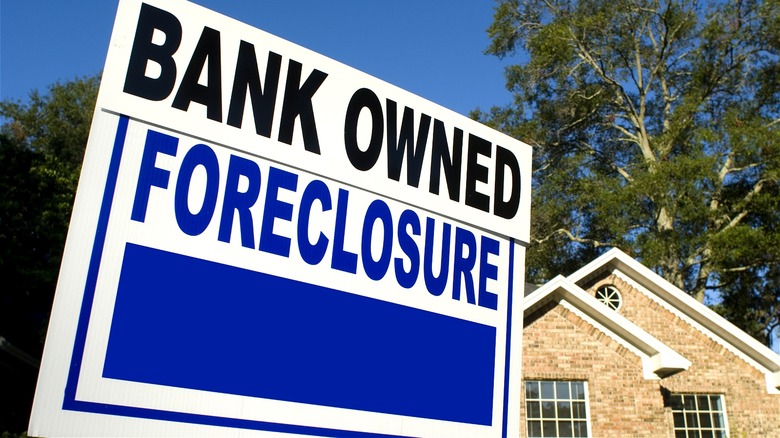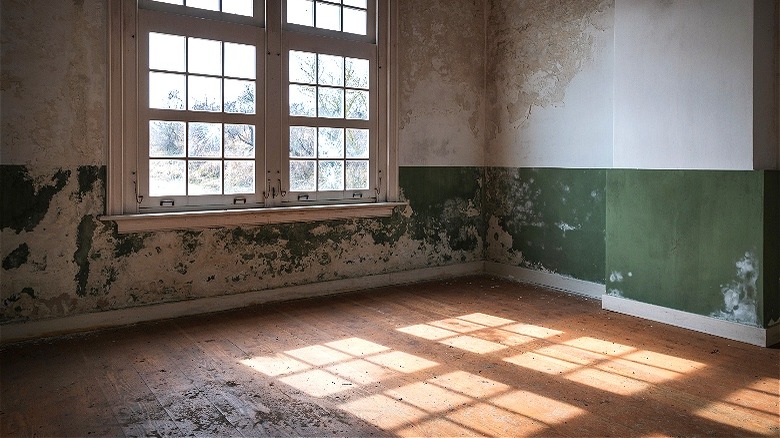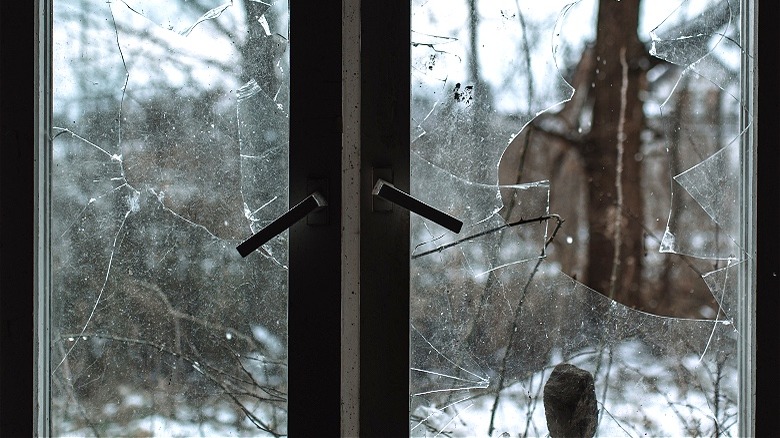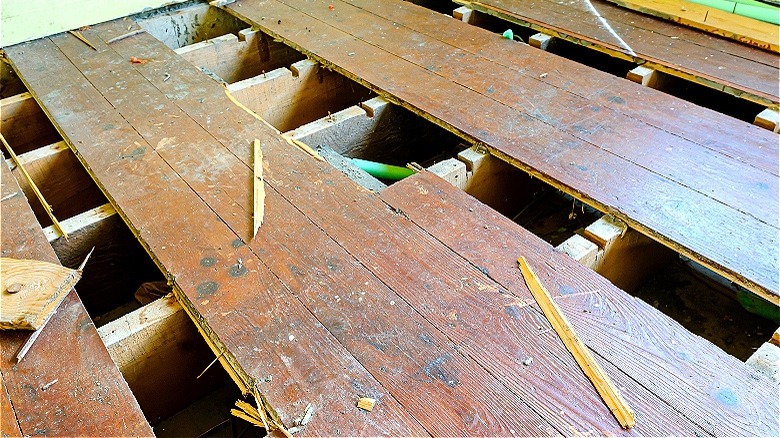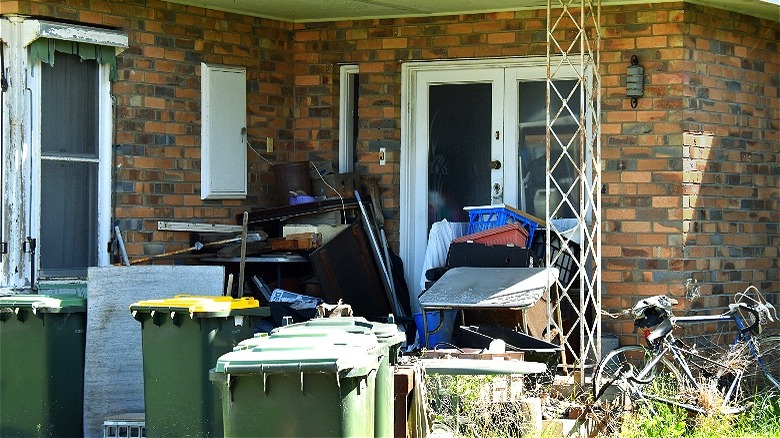Problematic Things You'll Find In A Foreclosed Home
Foreclosure is a fraught space in the real estate market. For the homeowners losing their property, foreclosure is a bitter pill that may come at the end of a long financial battle to stay above board with increasing failure to keep up with mortgage payments. But for homebuyers of real estate properties, foreclosure means something entirely different. However, these types of homes can often position themselves as a sort of double-edged sword.
For one, "foreclosure" doesn't entail the swift removal of a resident from their home. Instead, the foreclosure process runs its course over the span of months, perhaps even a year or longer. During this time, some homeowners will work diligently to square things away and prevent their ultimate removal from the home, while others will plan their eventual landing elsewhere and look to the future, resigned to their fate in this home.
It's often difficult to determine how a resident will cope with the foreclosure process, and so once a home is repossessed, the overall state of the property can be a bit of a mixed bag. Banks aren't really in the market to act as sales agents, so they don't typically spend much time fixing potential issues, cleaning up a home, or even evaluating its condition. Foreclosures are generally marketed "as-is," so buyers eyeing a foreclosed home will literally get what they pay for, warts and all. While foreclosed homes can be a solid financial opportunity, they also tend to close with some problematic quirks.
Poor maintenance and an overall state of disrepair
Even the best properties on the foreclosure market are likely to be left in a general state of disrepair. In many instances, previous owners become increasingly disinclined to care for the property, as their clock ticks down to zero in the home. Whether through shifting priorities or intentional neglect — in an effort to "stick it to the bank" — these homes generally show off quite a bit of dirt and grime.
A former owner will often decide it's no longer worth their while to clean up around the home, fix broken features, or repair cosmetic issues, leaving the home to deteriorate in the final weeks/months of their tenure. Other owners will intentionally break things. Baseboards and windowsills are often damaged or torn out in foreclosed homes. Since these features are fixtures mounted directly into the framework of the walls, they leave behind considerable damage if they're simply ripped away.
As well, a foreclosure may sit in the bank's possession for months, or even years before it sells to a new buyer. During that time, the property might sit vacant and sealed up, allowing any moisture and dirt inside the home to fester and degrade its general livability. Alternatively, people might use the home as a squatting base or otherwise, potentially treating it poorly in the process.
There's a high vandalism potential, too
Vandalism may be the result of numerous factors, but it remains a common sight in the foreclosure space. At its simplest, a former owner might break a window or two in order to access the property after a bank has locked them out. This might be simply as a means of collecting belongings that may have been left behind, but it could equally form an attempt to intentionally damage the foreclosed home in retaliation for the circumstances they find themselves in.
The longer a foreclosure sits vacant, however, the higher the probability becomes that it eventually serves the needs of some form of squatter. People may use vacant properties for all kinds of reasons. From the youth parties that sometimes make their way onto the TV to seedier recreational purposes, there's plenty of potential ways in which a vacant home can be severely damaged through vandalism and impropriety. All manner of damage should be expected when purchasing a foreclosure, because there's simply no way to know whether or not the home has been intentionally sabotaged by the previous owner or used as a crash pad by others after they left.
Stolen essentials like copper pipe, doors, and appliances
The removal of various key items is commonplace in the foreclosure arena, too. Once again, the longer a property sits vacant the more opportunity that vandals and thieves have at their disposal to damage and empty out a home. Doors, appliances, and copper pipes are common targets for both previous owners and enterprising thieves looking to make off with a home's valuables.
Obviously, an occupied property doesn't make for a good target for theft when considering these kinds of items. But in a foreclosure, a thief might come in the night to scope out potential items of value, and then return dressed as a cleaner to remove things. Cleaning up foreclosure properties is actually quite a lucrative business today, and banks will sometimes work with companies to spruce up a place rather than leaving all the work to a future buyer. This is but one possible example, but plenty of other avenues for theft in vacant homes remain open to criminals.
In a home that features radiator heating, for example, there's likely to be a great many yards of copper piping crisscrossing throughout the home's subfloor. Pulling up floorboards and breaking into walls will expose these pipes that offer pretty solid resale value. Thieves might also target a home's doors, chandelier lighting, and sometimes other building materials, such as timber framing, roofing shingles, wire, or kitchen and bathroom fixtures. No matter the target, a foreclosed home that has seen a theft of leftover items is often one that's also quite damaged.
Don't be surprised to encounter items left behind
It shouldn't be a surprise to walk into a barren home that you have bought in foreclosure. Yet, the opposite side of the coin is equally true. It can be a common sight to open the door and be overtaken by mountains of trash and junk left by the previous owner. As noted, many banks won't clean out homes they've repossessed in foreclosure and simply hope to shift them as is. Sometimes this can mean selling an immensely dirty and grimy home. Banks typically aren't seeking to create a profit on a foreclosure sale, but rather cutting their losses — if there are any. Offloading the home as fast as possible is the aim here, even if that means taking a hit. Again, banks aren't generally in the business of managing rental properties or selling homes. They make their money by providing the funding, not buying and selling assets.
Sometimes, a repossessed home will see a sharp decline in quality maintenance from the owner as they prepare to make their move elsewhere. But this isn't the only reason for a buildup of junk in a foreclosure. Banks may ultimately choose to forcibly evict a stubborn homeowner. This can have the effect of essentially freezing the home in its current state, trash and all. But junk doesn't generally stand still. Organic material can fester, dust collects in thick layers on things, and the presence of water can send the entire atmosphere into a whirlwind of chaos. Don't be surprised to find quite the mess in a foreclosure, alongside plenty of personal belongings.
Mortgage finalization can be tricky with foreclosures
Finally, homebuyers interested in a foreclosure will often find something in the process that isn't physically inside the home or the property's boundary. A foreclosure offers a rock-bottom price on a potentially quality home, even if it comes full of the previous owner's things and their mess. You might be buying for the neighborhood or the general location within the community, and so a big renovation job is a fine trade-off for the steep discount in purchase price.
With this said, working with traditional lenders isn't always straightforward when investing in a foreclosure. Many of these homes are deemed uninhabitable when they hit the market, and it can be difficult or impossible to secure mortgage financing for a structure of this designation. Even with financing secured (through a willing lender or as a cash purchase, for instance), the math may not always work in your favor. Because a home foreclosure can require tons of work to prepare for a resident, you'll need quite a bit of lead time before moving in, renting, or selling the home.
Managing the finances of your existing home alongside the renovation or engaging in a remodel designed to eventually bring in rental income can be strenuous at the best of times. The financials of a foreclosure are often tricky, bringing in a new dimension to the problems found within this segment of the marketplace.
